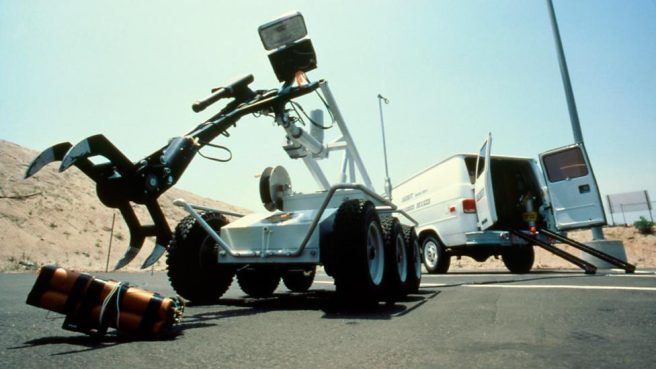When were the first bomb disposal robots used?
One of the very first uses of a bomb disposal robot goes all the way back to 1972. The robot used was known as Wheelbarrow Mark 1 and was thought up by Lieutenant-Colonel Peter Miller of the British Army.
He came up with the innovative idea of using the chassis of an electric wheelbarrow to tow any suspected bomb devices. The suspected bomb would be moved to a place where the bomb could be safely detonated.
The Wheelbarrow Mark 1 proved very difficult to maneuver and was soon upgraded and improved for better mobility. The robot was then upgraded again to include the capability to disarm the bomb, rather than just tow it away for detonation.
Telemax PRO Description
The Telemax pro bomb disposal robot is considered as the most versatile of it’s kind in the industry. It is widely used in the army and is small enough to fit in the back of an SUV, making it useful for a wide variety of bomb disposal missions.
The Telemax Pro comes with a four-track running gear, which gives it superior mobility when compared to similar robots. The manipulator can reach gradients if 45° with very difficult and is strong enough to deal with most situations.
This robot is capable of extreme climbing and obstacle maneuvering. It has an extensive reach and is the go-to bomb disposal robot for small or confined spaces. It has a precision manipulator with seven axes with TCP control and an automatic tool change.
The Telemax Pro can lift to 20kg of weight and can move at 10 km/h using its 4-chain drive. The robot comes with over 30 pre-programmed movements for both the manipulator and the drive.
How Does the Telemax Pro Work?
Using a combination of dc servo drives and motor controllers, the Telemax Pro can be fully remote-controlled by the bomb disposal engineer. The drives create enough torque for the arm to work with substantial weight but remain light enough to move at speed.
This robot is quick and intuitive, capable of complex maneuvers, and works at high precision. It will find and remove objects quickly and easily, even in confined spaces such as luggage compartments on an airplane.
Challenges
The weight of the controller is crucial when selecting the right drive for the robot. The batteries and motors account for most of the 80kg of the total weight of the Telemax Pro.
The actual size of the robot and the manipulator’s arm need to be kept as small as possible so that it is effective at moving around in confined spaces. Not only does the robot have to be as small as possible, but it also has to retain a certain amount of strength to be able to be effective.
These challenges are realized using an integration of servo drives placed inside the joints of the manipulator’s arm. This involves a decentralized architecture with less wiring and less EMI using short motor wires.
Other challenges when creating the Telemax Pro robot included providing the drives need for the 24 VDC battery supply that can support a high current. The battery application also requires high efficiency to support an operating time of 2 hours.
The Telemax Pro also required CANopen communication to keep it fast and synchronized in its movement. The manipulator movement has to stay smooth and incredibly precise at the same time.
Solutions
To overcome these challenges faced when creating the Telemax Pro, the Tweeter and Whistle Servo Drive Controller were agreed to be the lightest options while still retaining its high performance. They were also by far the most efficient and intelligent servo controllers for this particular application.
The motion control units offer a generous peak current. Almost twice the nominal current and delivered over just 3 seconds, beneficial for when the manipulator needed to be forced beyond it’s rated range.

